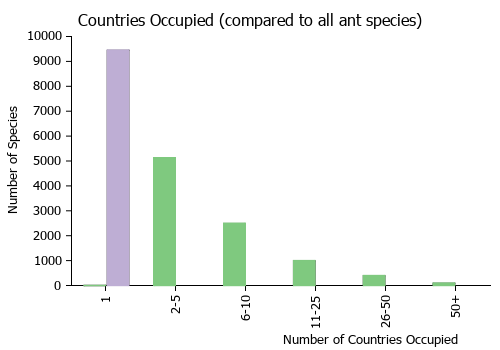Pheidole quercicola
| Pheidole quercicola | |
|---|---|
| Scientific classification | |
| Kingdom: | Animalia |
| Phylum: | Arthropoda |
| Class: | Insecta |
| Order: | Hymenoptera |
| Family: | Formicidae |
| Subfamily: | Myrmicinae |
| Tribe: | Attini |
| Genus: | Pheidole |
| Species: | P. quercicola |
| Binomial name | |
| Pheidole quercicola Wilson, 2003 | |
This species is only known from type specimens. The type colony was collected at a relatively high elevation in humid pine-oak forest. (Wilson 2003)
Identification
See the description in the nomenclature section.
Keys including this Species
Distribution
Only known from the type locality.
Distribution based on Regional Taxon Lists
Neotropical Region: Mexico (type locality).
Distribution based on AntMaps
Distribution based on AntWeb specimens
Check data from AntWeb
Countries Occupied
| Number of countries occupied by this species based on AntWiki Regional Taxon Lists. In general, fewer countries occupied indicates a narrower range, while more countries indicates a more widespread species. |

|
Estimated Abundance
| Relative abundance based on number of AntMaps records per species (this species within the purple bar). Fewer records (to the left) indicates a less abundant/encountered species while more records (to the right) indicates more abundant/encountered species. |

|
Biology
Castes
Nomenclature
The following information is derived from Barry Bolton's Online Catalogue of the Ants of the World.
- quercicola. Pheidole quercicola Wilson, 2003: 492, figs. (s.w.) MEXICO.
Description
DIAGNOSIS Similar in various traits to Pheidole bilimeki, Pheidole chalca, Pheidole daphne, Pheidole floridana, Pheidole furtiva, Pheidole nebulosa, Pheidole specularis and Pheidole stomachosa, differing as follows.
Major: yellow; profile of promesonotal dorsum flat in side view, descending to metanotum in steep posterior face; humerus discrete and lobose in dorsal-oblique view; occiput broad and deeply concave; postpetiole conate from above; posterior half of head smooth and shiny; and anterior half of dorsal surface of head carinulate; lower margin of pronotum carinulate; middle of mesopleuron with band of broken rugulae.
Minor: occiput broad, strongly concave; promesonotal profile semicircular; propodeal spine equilaterally triangular; postpetiolar node strongly developed in side view; almost all of body smooth and shiny.
MEASUREMENTS (mm) Holotype major: HW 1.06, HL 1.12, SL 0.50, EL 0.14, PW 0.54. Paratype minor: HW 0.52, HL 0.58, SL 0.48, EL 0.08, PW 0.34.
COLOR Major: concolorous medium yellow.
Minor: concolorous light yellow.
Figure. Upper: holotype, major. Lower: paratype, minor. Scale bars = 1 mm.
Type Material
MEXICO: vicinity of Omilteme, Guerrero, 2300–2500 m, col. Cornell University Field Party, 1965. Museum of Comparative Zoology
Etymology
L quercicola, oak-dwelling, allusion to habitat of type colony.
References
- Wilson, E. O. 2003. Pheidole in the New World: A dominant, hyperdiverse ant genus. Harvard University Press, Cambridge, MA. (page 492, fig. major, minor described)
References based on Global Ant Biodiversity Informatics
- Vasquez-Bolanos M. 2011. Checklist of the ants (Hymenoptera: Formicidae) from Mexico. Dugesiana 18(1): 95-133.
- Vásquez-Bolaños M. 2011. Lista de especies de hormigas (Hymenoptera: Formicidae) para México. Dugesiana 18: 95-133
- Wilson, E.O. 2003. Pheidole in the New World: A Dominant, Hyperdiverse Genus. Harvard University Press
